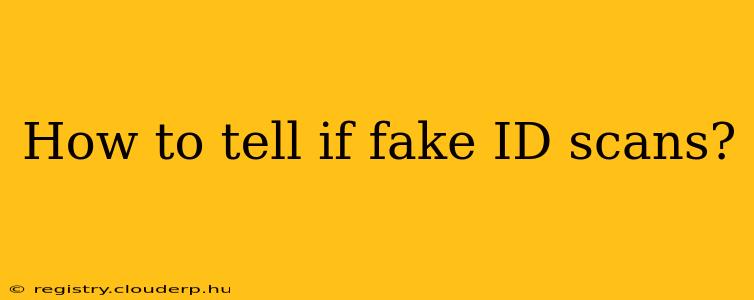The proliferation of fake IDs has made verifying their authenticity a crucial skill, whether you're a business owner, a law enforcement officer, or simply someone concerned about potential fraud. While a physical ID requires tactile examination, a scan presents a unique set of challenges. This guide will equip you with the knowledge to identify potential red flags in a digital ID scan.
What are the common red flags in a fake ID scan?
Fake ID scans often exhibit subtle yet noticeable discrepancies compared to genuine scans. These inconsistencies can arise from various factors, including the quality of the forgery, the scanning process itself, and the digital manipulation techniques used to create the fake.
Poor Image Quality
One of the most obvious giveaways is poor image quality. A blurry, pixelated, or otherwise low-resolution scan immediately raises suspicion. Genuine ID scans are typically crisp and clear, exhibiting sharp details and legible text. Look for uneven lighting, washed-out colors, or areas where the image is significantly distorted.
Inconsistencies in Font and Design
Authentic IDs follow specific design templates with unique fonts and layouts. A fake ID scan might exhibit inconsistencies in font styles, sizes, or spacing compared to genuine examples. Small discrepancies, such as slightly off-center elements or unusual kerning (spacing between letters), can be indicative of forgery. Cross-reference the scan with an official sample of the particular ID type to spot anomalies.
Suspiciously Perfect or Unnatural Images
While a genuine scan might have minor imperfections, a fake might appear suspiciously perfect. This could be due to over-processing during creation, resulting in an overly smooth or artificial-looking image. Examine for unnatural textures, unrealistic skin tones, or a lack of minor imperfections that are typically present in real photographs.
Missing or Incorrect Security Features
Many IDs incorporate security features, such as watermarks, holograms, or UV-reactive inks. While these features are not always visible in a digital scan, their absence or incorrect representation can be a major red flag. Research the security measures associated with the particular ID type and compare them to what's presented in the scan. Even a slight discrepancy should raise suspicion.
How to Verify an ID Scan More Effectively?
Beyond simply visually inspecting the scan, there are further steps you can take to increase the accuracy of your verification efforts:
Use Multiple Verification Methods
Relying on visual inspection alone might not be sufficient. Consider integrating additional verification methods, such as comparing the information presented in the scan with other reliable sources, or utilizing specialized ID verification software designed to detect forgeries.
Request Additional Information or Documentation
If you are still unsure, consider requesting additional documentation or information from the person presenting the ID. This could include other forms of identification, address verification, or other supporting details to bolster the credibility of their claim.
Stay Updated on Forgery Techniques
The methods used to create fake IDs are constantly evolving. Therefore, it's essential to stay up-to-date on the latest forgery techniques and technologies to better equip yourself for effective verification. Regularly review resources and training materials from relevant authorities or organizations.
What if I suspect a fake ID scan?
If you suspect that an ID scan is fraudulent, report your suspicions to the appropriate authorities. Do not hesitate to contact law enforcement or the issuing agency responsible for the ID. Providing them with the suspected fake ID scan can help them investigate the matter and prevent further fraudulent activities.
Remember, verifying a digital ID scan requires a careful and thorough approach. Combine visual inspection with additional verification methods and stay updated on the latest forgery techniques to enhance your ability to identify fake IDs and protect yourself from potential fraud.

